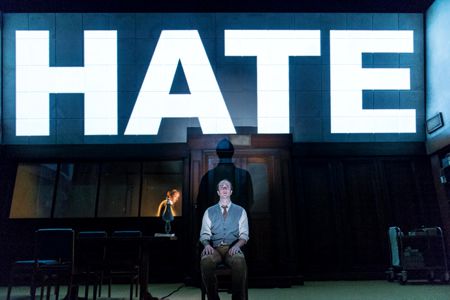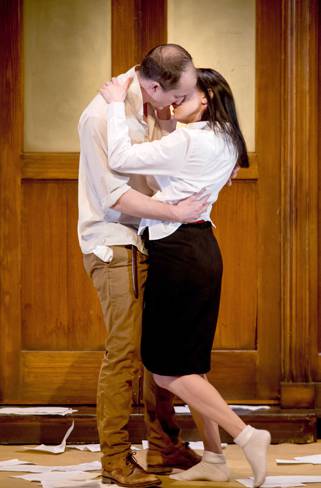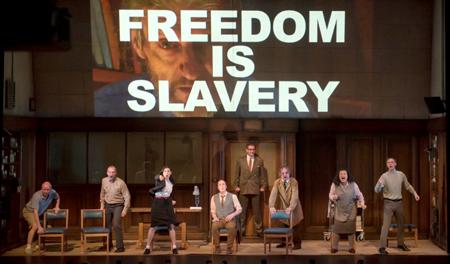Play
by George Orwell
Adapted and Directed by Robert Icke & Duncan Macmillan
A Headlong, Almeida Theatre,
and Nottingham Playhouse Production
American Repertory Theater
Loeb Drama Center, Harvard University
Cambridge, MA
February 14 – March 6, 2016
Design: Chloe Lamford; Lighting: Natasha Chivers; Sound: Tom Gibbons; Video: Tim Reid
With Matthew Spencer (Winston), Hara Yannas (Julia), Simon Coates (Parsons), Tim Dutton (O’Brien), Stephen Fewell (Charrington), Christopher Patrick Nolan (Martin), Ben Porter (Syme), Mandi Symonds (Mrs. Parsons)

in ‘1984’
Photo: Manuel Harlan
Courtesy of American Repertory Theater
Winston Smith (Matthew Spencer) lives in terrestrial hell – the dystopian empire of Orwell’s imagined universe, one drawn from the Stalinist one and extrapolated without national or cultural specificity. The novel is about the horrors of a modernist autocracy gone wild, one that invades privacy and converts the minds and steals the fidelities of almost all who are held under its sway.
Counter to these tyrannical impositions, Winston falls in, and in love, with Julia (Hara Yannas), another subliminal resister to the powers that be. As one knows from the novel, things don’t turn out all that well for them in the end.
The one major curiosity of this adaptation is that it emphasizes, to some extent, the significance of the appendix of the original novel. Unfortunately that appendix was suppressed in the early printings in the United States at the request of publishers here. That appendix contextualizes the horrors and reflects back upon 1984 from the position of a century later when things have eased up and gotten significantly better. This production offers a few nods in that general direction, delivering, in the midst of the prevailing horrific dreariness, some sense of hope.
Nonetheless, before there is hope there is despair and a good deal of violence, physical and psychological.

Hara Yannas as Julia
in “1984”
Photo: Ben Gibbs
Courtesy of American Repertory Theater
This production is, in quite a few ways, effective, but bleak, harsh and difficult to watch.
Video (by Tim Reid) is used in an interesting way. Many of the scenes between Winston and Julia are shown projected on a large central screen while the actors are offstage. It’s an interesting effect – a movie in real-time. However, after a certain amount of it – it was used quite extensively – it seemed like enough.
Strobe lights and bright flashes of other sorts (by lighting designer Natasha Chivers), along with jarring and jagged noises (by sound designer Tom Gibbons), are used extensively as well. Those, too, were effective in a more pronounced way in their first few doses; later on they called up a not this again feeling, though that may well, and understandably, have been the intent of this difficult production.
There are striking and witty lines throughout, mostly playing off the Orwellian fascination with Newspeak, the modification of language that enables the manipulation of thought. Much of the lingo of 1984 has become so common that there’s nothing terribly unfamiliar about its code words – doublethink, big brother, ministry of truth, blackwhite, thought crime, thought police – but they are still creepy. Helpfully, the printed program offers a pretty full lexicon with definitions.
Despite the generally grim demeanor, there was one scene which struck me as funny in a dark and contemporary way. In the world of this awful future, a practice called the Two Minute Hate is enacted by lining everyone up and having them scream mercilessly when objects of the state’s derision are mentioned. As I watched the row of eight or so characters spew their all I found my imagination wandering back to some of the recent Republican candidate forums, thinking the two scenes were not all that different.

Photo: Ben Gibbs
Courtesy of American Repertory Theater
A quite dramatic turn of events near the end has the surveillance video go berserk in an interesting way, showing screens splitting like cancer cells and computer code spraying itself all over the place. The effect is jarring, and suggests a parallel between the rather quaint Orwellian vision of surveillance and something more totally modern. These suggestions of contemporary issues are suggestively hinted at here and there, but not further explored.
The production is grueling, but the inner love story between Winston and Julia provides a sweet core, however doomed its destiny.
Prepare oneself for violence and gore. Despite the relatively short length of the show, those scenes, because of their horror, attenuate.
– BADMan
Leave a Reply